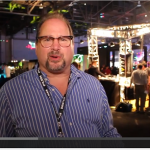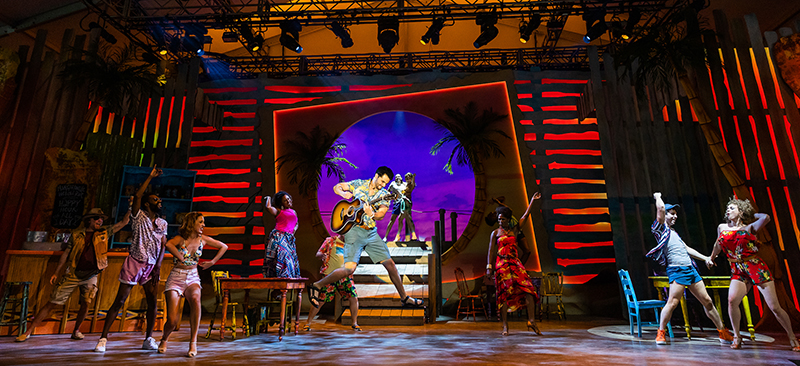
As theaters began to plan for the summer ‘21 season, many states were just emerging from pandemic restrictions, but with no guarantee there wouldn’t again be restrictions. While some traditionally indoor theater companies could address COVID protocol concerns and still reopened indoors, several theaters instead opted to plan outdoor seasons. Theater this summer has moved to tents, parking lots, open-air garages, local parks, and even drive-ins. By creating new venues, theaters can better plan and account for limited audience capacity, social distancing, and accommodating safety guidelines for the actors and crews. We spoke recently with a company in Maine that looked outside their front door and saw the perfect space to transform.
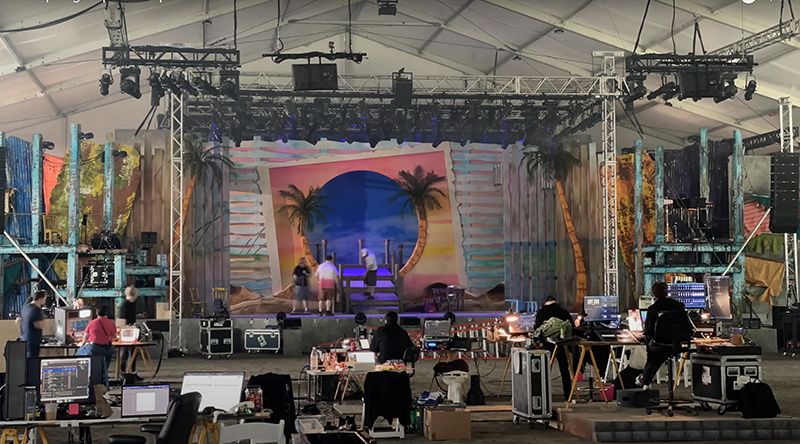
The Leary Pavilion – The Ogunquit Playhouse
Listed on the National Register of Historic Places, The Ogunquit Playhouse in Ogunquit, ME, founded in 1933 by Walter and Maude Hartwig, is one of the last remaining summer theatres of the Straw Hat Circuit still producing live musical theatre. This summer they are adding to their history with a move to the great wide open expanse of their south lawn, where they erected a 25,700-square-foot open-air venue—nearly three times the size of their indoor theater. Designed to give audiences the safest possible environment to enjoy a season of four musicals from June through October, the new Leary Pavilion is a fully covered steel structure with a 96-foot-wide stage, lighting and sound hanging positions and a fully enclosed front of house control booth. Currently arranged for socially distanced seating of 550, it can easily be altered to meet changing capacity guidelines.
With the first show of the season, Spamalot, under their belts and having just opened Escape to Margaritaville Ogunquit’s Production Manager Amanda Woodward, and Technical Director Geof Dolan discussed with us building and working in the Leary Pavilion. This is Woodward’s third season at the Playhouse and the 16th season for Dolan, so they knew well the needs of the company when they started planning the season. Factoring in ever-changing restrictions and Equity work rules which were still being finalized, Dolan notes that “A tent seemed to be the most logical way to plan on dealing with issues like distancing, for both the audience and the crews.” Woodward agrees, “One of the challenges was feeling safe and comfortable for the crews. We started studying all the suggested protocols before the season even opened. We reached out to department heads and asked them for guidance on how they would like to run their specific areas. We based a lot of our protocols on their feedback as well as CDC guidelines mandates and the ones from AEA (Actors’ Equity Association). Currently, we are a fully vaccinated company and if you are unable to be vaccinated, then we ask you to wear a mask while working. We also do multiple testing throughout the week.”
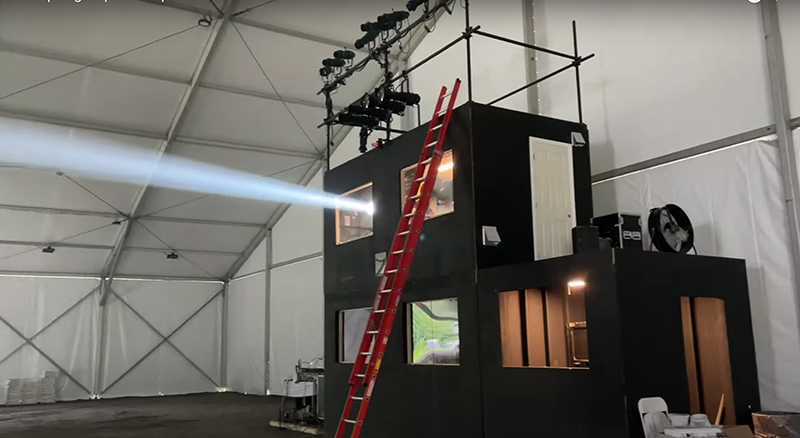
Plenty of Space
The pavilion tent itself was supplied by American Pavilion and is a 132-foot by 197-foot clear-span tent structure. It has 16-foot-tall sides and is 37-feet to the center peak. “It’s great because it has no center support,” Dolan explains. “The stage deck is three-feet off the ground, and we measure 96-feet wing to wing. From the edge of the apron all the way to the back is about 33-feet deep. We’ve got about 2,600-square-feet of stage and supporting space, including the dimmer and power distro room, booth, etc. that we also had to build. We built the entire wood structure of the stage ourselves. We used 14,264-feet of lumber—about 2.7 miles of a lumber—and about 10,000 pounds of plywood, for just the structure.” Woodward adds, “for the hardware, the Playhouse turned to local vendor Eldredge Lumber and Hardware. Costs of lumber have skyrocketed over the last couple of months. In general, most supplies, steel included, have also increased so that affects our bottom line as well.”
The Playhouse’s lighting equipment is only a few years old, so Woodward and Dolan didn’t want to void any warranties by taking their own gear outside and instead chose to rent the entire lighting package from PRG. The rig for the summer includes Martin Mac Vipers, ETC Source 4 LED Series 2 Lustrs, Chauvet COLORado 2 Solo Zooms and Color Kinetics ColorBlasts and ColorBlazes with two Lycian 1293 X3K followspots. For control they’re using an ETC Ion Xe 12k with an ETC Eos Programming Wing and an ETC 2×20 Fader Wing. They get tape and supplies from Production Advantage and installed a self-climbing truss system, rented from High Output. “Our people worked with their engineers to make sure we had everything spec’d out properly for the space,” states Dolan, adding, “The Master Electrician calculated that we had to run about five-miles of cable for our lighting system.”
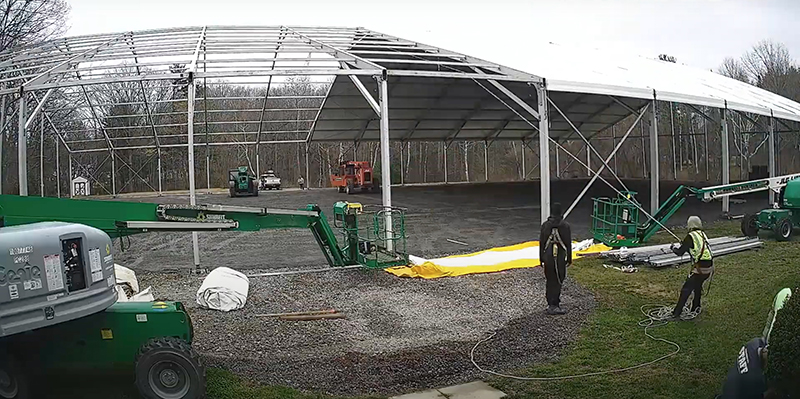
Production Advice
We asked them to offer advice to other PMs and TDs when considering taking theater outdoors. For Woodward, “It’s heat. Think about your spot ops and how they operate. What happens to them when they’re exposed to the elements or are they in an enclosed booth with an air conditioner? It gets very hot in there. I would also just advise everybody taking the extra time in their work calls and being cautious of the wind when working at height.”
From Dolan’s perspective, his advice is also to “add extra time. You don’t have the same support system as in your building to say, fly a wall, or bring a scissor lift in. Add some time and buffer accordingly. Also, get as many eyes on the project as you can. We brought in rigging specialist Bill Sapsis to come in and just verify some things. Along with the tent structure and the self-climbing truss, we had a number of front of house positions. We worked with the tent company as far as weight, and what loads can happen. We all have a lot of experience, but in theater there’s never anything wrong with getting another set of eyes on something. Then watch your time and plan everything within an inch; just walk in prepared.”
Woodward cautions to also “have a lot of patience as well. Talk to your crew and cast and giving them heat breaks, provide plenty of water and have safety measures in place, and ways to cope. The heat is a big one to mentally prepare for and plan how to manage. For example, we keep our dressing rooms, on exceptionally hot days, a bit warmer than normal so there isn’t that shock to the body when going outdoors and vice versa. We are also providing sweat towels that soak in ice for the crew and performers as well, to help mitigate the heat and prevent dehydration. We have multiple fans backstage to keep airflow going. Then we provide electrolyte powder for drinks on those days where it’s exceptionally humid and hot to help replenish and keep hydrated.”
Halfway into the season and Woodward and Dolan are pleased with the new tent venue. It was a huge challenge and we pulled it off,” comments Dolan. “I think, it’s working for us very, very well and I’m glad that we’re back doing live theater again. I relish that we got the opportunity to do this, but I also cannot wait to go back indoors of my beloved building.” Woodward agrees, saying. “It’s really been great, and every show provides a new, exciting adventure. It’s been a beautiful challenge that I would never trade away. It could have been so much harder to do, but because we have such a phenomenal team, it’s really, knock on wood, it’s been quite a good adventure so far.”

